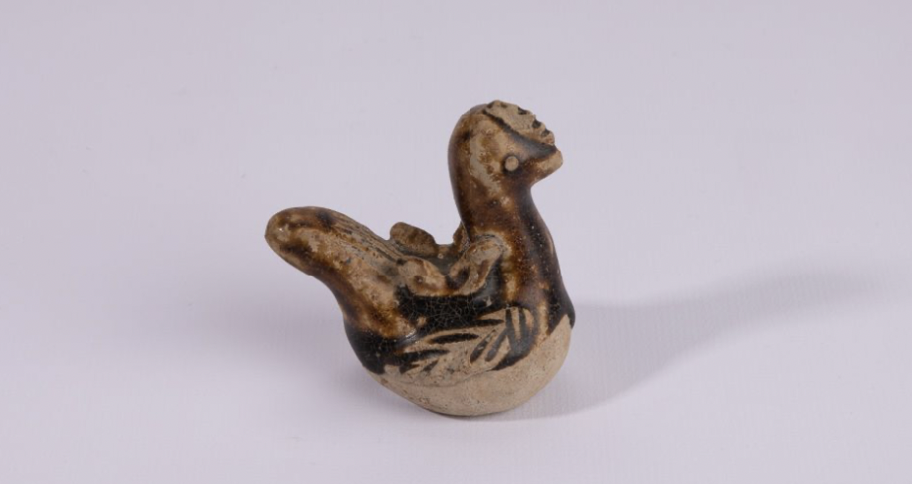Si Satchanalai Chicken Figurine
Si Satchanalai Chicken Figurine

Si Satchanalai Chicken Figurine
15th-16th Century, Ayutthaya Period
Stoneware with Brown Glaze
2.5 in x 2.5 in
Sawankhalok kilns, Si Satchanalai, Sukhothai province, North-central Thailand
1985.070
Pottery from central Thailand, created during the Sukhothai (1238-1438) and Ayutthaya (1351-1767) eras, was heavily desired throughout East and Southeast Asia.1 Ceramic wares specifically from the city of Si Satchanalai, like the chicken figurines displayed above, as well as bowls, jars, and other vessels, have been found in shipwrecks in the South China Sea and surrounding areas.2 This suggests at least a modestly large volume of trade in ceramics between Thailand and nearby states such as China, Indonesia, and Vietnam. Why was this pottery so desired throughout the region?
Aesthetically, ceramics of this era found many influences in Chinese and Vietnamese wares; the use of brown glazes, black underglazes, and celadon in Thai pottery of this era is closely linked to the works of these neighboring states.3 However, Thai artisans also added their own aesthetic flourishes to this era’s ceramics in order to distinguish them from those of different regions.4 Additionally, many potters specialized in a specific vessel or figurines and had signature designs, thus meaning that the quality of the ceramic works was incredibly high.5 Thus, it becomes clear that at least part of the desire for Thai pottery of this era was due to the wares’ aesthetic excellence and high-end craftsmanship. However, given the partial aesthetic similarity of Thai wares to those of the regions they were traded to, it’s suggested that some other factor, perhaps religious or ritualistic, also contributed to the popularity of these ceramics. Both Thailand, the source location of these wares, and many of their trade destinations were either majority-Buddhist or have a history of Buddhist empires, leading to the suggestion that these ceramics, like the chicken figurine, occupy some role in Buddhist ritual or thought.
The reason why the trade of figurines like these from Si Satchanalai was abundant throughout Asia could be attributed to the importance of motherhood in Buddhism–a major religion believed in Asian countries–and the inherent presence of maternal care in the chicken figurine.6 This figurine depicts a hen tenderly carrying two baby chickens on its back, demonstrating the familial bond between animals. Sculptures that represent a mother and her child(ren)–like this chicken figurine–are usually called “maternity figures”, which symbolize the essence of motherhood. Maternity figures among the Si Satchanalai figurines are represented either as human mothers in various postures (breastfeeding, holding a child across the shoulder, etc.) or as animal mothers with offspring(s) on their backs.7 During the Ayutthaya period, these figures served an intimate and practical purpose within the family unit, reflecting the societal gender role that emphasized females’ responsibility in caring for the children of the family.8 During that time, the state religion of the Ayutthaya Kingdom was Theravada Buddhism.9 King Ramathibodi (r.1351–69) invited monks from nearby Sri Lanka (country in South Asia) to preach its doctrine, in which the idea of maternal nurture being a religious metaphor became widely accepted in Southeast Asian societies, where motherhood was highly valued.10 Positive perceptions of motherhood were fostered through depictions in sermons, folk operas, courting songs, agricultural rituals, and myths.11 Motherhood, in other words, embodied the wisdom of raising children and loving relationships that were passed on from generation to generation. As a result, maternity figures like this chicken figurine were made as educational toys to impart valuable lessons on motherhood to young girls.12 Children who played with these figurines acquired insights into parenting and the universal affectionate bond between mothers and children among not only humans but also animals.13
Admittedly, some may argue that this chicken figurine might also serve as a votive offering–an object presented as a token of gratitude to a deity–since maternity figures were usually connected with it. However, votive offerings during the Ayutthaya period often took the form of tablets that portrayed the pre-enlightenment scene of the Buddha (Siddhartha Gautama), featuring him seated in meditation beneath the bodhi tree.5 Therefore, even though the chicken figurine does reflect the maternal value respected by Buddhist societies, it does not directly represent the religion due to the absent reference to Buddha’s pre-enlightenment.
Jenna Jang
Neuroscience and Data Science
Class of 2026
Meggie Huang
Cinematic and Media Arts
Class of 2025
Annotated Bibliography
“14th Century Thai Ceramic.” Bowers Museum, April 20, 2018. https://www.bowers.org/index.php/collection/collection-blog/14th-century-thai-ceramics.
Andaya, Barbara Watson. “Localising the Universal: Women, Motherhood and the Appeal of Early Theravāda Buddhism.” Journal of Southeast Asian Studies 33, no. 1 (2002): 1–30. https://doi.org/10.1017/s0022463402000012.
Chirapravati, Pattaratorn. The cult of votive tablets in Thailand, sixth to thirteenth centuries, 1994.
Fry, Gerald W., Gayla S. Nieminen, and Harold E. Smith. Historical dictionary of Thailand. Lanham, MD: Scarecrow Press, 2013.
“The History of Thailand.” Essay. In Thailand’s Beaches and Islands, 38–45. London: Dorling Kindersley, 2012.
Khumbutshya, Wanaporn. “Si Satchanalai Maternity Figurines: Loving Relation between Mother and Child.” Southeast Asian Ceramics Museum 9, no. 3 (2016): 4–5.
“Religions by Continent.” Yearbook of International Religious Demography 2016, 2016, 83–93. https://doi.org/10.1163/9789004322141_003.
Snellgrove, D. Llewelyn , Tucci, . Giuseppe , Reynolds, . Frank E. , Kitagawa, . Joseph M. , Lopez, . Donald S. and Nakamura, . Hajime. “Buddhism.” Encyclopedia Britannica, October 15, 2023.
Sukkham, Atthasit. “Si Satchanalai Figurines: Reconstruction of Ancient Daily Life, Beliefs, and Environment in Siam during the Sixteenth Century.” International Journal of Historical Archaeology 22, no. 4 (2017): 800–842. https://doi.org/10.1007/s10761-017-0449-7.
